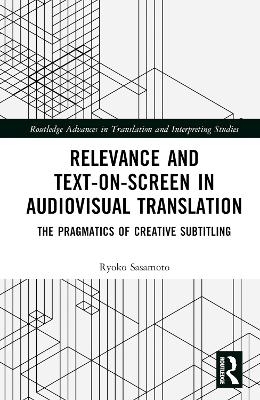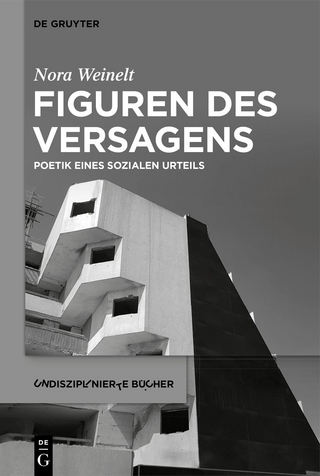
Relevance and Text-on-Screen in Audiovisual Translation
Routledge (Verlag)
978-1-032-13970-8 (ISBN)
This book examines audiovisual translation (AVT) practices that fall outside conventional AVT norms, drawing on work from relevance theory to highlight alternative perspectives and make the case for a multidisciplinary approach to AVT.
The volume focuses on creative subtitling – otherwise known as 'text-on-screen' – through the lens of relevance theory, a cognitively grounded theory of communication. Sasamoto explores the ways in which a relevance theoretic approach can provide an analytical framework for a better understanding of the interaction between 'text-on-screen' and viewers' interpretation processes and, in turn, how media producers, professional or otherwise, use 'text-on-screen' to engage viewers in innovative ways. The volume looks at such forms as telop, creative text use on screen, and forms of user-generated text-on-screen.
The book introduces a new dimension to work on cognative pragmatics and the wider applications of relevance theory in multimodal communication and AVT, making it of interest to scholars in these disciplines.
Ryoko Sasamoto is Associate Professor in the School of Applied Language and Intercultural Studies (SALIS) and a member of the Centre for Translation and Textual Studies (CTTS) at Dublin City University, Ireland.
Contents
List of Figures
List of Tables
Acknowledgement
1. Text-on-Screen
1.1 Introduction
1.1.1 Examples of Text-on-Screen
1.1.2 Emergence and Historical Development
1.1.3 Typologies of Text-on-Screen
1.1.4 Terminology
1.2 Prevalence of Text-on-Screen
1.2.1 Methodology
1.2.2 Findings: Prevalence of Text-on-Screen
1.3 Towards a Pragmatics of Text-on-Screen
2. Cognitive-Pragmatic Approaches in Translation Studies
2.1 Introduction
2.2 Relevance Theory
2.3 Relevance Theory and Translation
2.4 Relevance Theory in Translation Studies
2.5 Relevance Theory and its Application to AVT Research
2.6 Relevance and Text-on-Screen: Key Notions
2.6.1 Epistemic Vigilance and Epistemic Trust
2.6.2 Context and Audience
2.6.3 Mutual Manifestness: Cognitive and Affective Mutuality
3. Creative and Innovative Subtitling: How Viewers Process Creative Pop-up Captions on TV
3.1 Telop: Basics
3.1.1 Text-on-Screen in Entertainment Shows and Drama
3.1.2 Reaction to Impact Captions: Previous Studies
3.2 Relevance-Theoretic Analysis
3.2.1 The Role of Telop: Viewer Manipulation
3.2.2 Telop and Affective Response
3.2.3 Telop and Cognitive Mutuality
3.2.4 Telop and the Two-Dimensional Space of Intended Import
3.2.5 Conclusion
4. Text-on-Screen and Social Impact: Vigilance and Trust
4.1 Misuse of Text-on-Screen
4.2 Epistemic Vigilance and Epistemic Trust
4.3 Epistemic Vigilance and Problematic Text-on-Screen Use
4.3.1 Misuse, Vigilance, and Trust
4.3.2 Epistemic Vigilance, Attributed Thoughts, and Mockery
5. An Empirical Approach to AVT: Overview of Eye-Tracking in AVT Research
5.1 Eye-Tracking as a Research Method
5.1.1 Introduction
5.1.2 Eye-Tracking
5.2 Development of Eye-Tracking Research in AVT
5.2.1 Early Research
5.2.2 Legibility, Readability, and Strategies
5.2.3 Individual Factors and Subtitle Processing
5.2.4 Subtitles in Academic Contexts
5.3 Non-Standard Subtitling and Creative Text-on-Screen
5.3.1 Eye-Tracking Research into Innovative Titling
5.3.2 Impact Captions and Eye-Tracking
6. An Empirical Approach to AVT: A Case Study – Eye-Tracking, Ageing, and Viewing Behaviour
6.1 Viewer Needs and AVT Research
6.2 Older Viewers, TV Viewing, and Cognitive Processing
6.3 Methodology
6.3.1 Design
6.3.2 Location and Participants
6.3.3 Types of Telop and Areas of Interest
6.3.4 Questionnaires
6.4 Findings
6.4.1 Study 1
6.4.2 Study 2
6.5 Discussion
6.5.1 Overall Attention to the Programme
6.5.2 Distribution of Attention
6.5.3 The Types of Telop and Impact on Reception
6.5.4 Viewing Habits and Recall
6.6 Conclusion
7. Participatory Culture, Social Media, and Text-on-Screen: Sharing Emotions via the Use of Creative Titling
7.1 Introduction
7.2 Shared Viewing
7.2.1 Overview
7.2.2 Shared Viewing Platforms: Danmaku/Danmu (Bullet Titling) and Live Commentary
7.3 Relevance of Live Comments: A Pragmatic Analysis 190
7.3.1 Sharing Information
7.3.2 Sharing Reactions 197
7.4. Conclusion
8. Conclusion and Future Directions
Index
| Erscheinungsdatum | 31.05.2024 |
|---|---|
| Reihe/Serie | Routledge Advances in Translation and Interpreting Studies |
| Zusatzinfo | 5 Tables, black and white; 43 Line drawings, black and white; 43 Illustrations, black and white |
| Verlagsort | London |
| Sprache | englisch |
| Maße | 152 x 229 mm |
| Gewicht | 520 g |
| Themenwelt | Kunst / Musik / Theater ► Film / TV |
| Geisteswissenschaften ► Geschichte | |
| Geisteswissenschaften ► Sprach- / Literaturwissenschaft ► Anglistik / Amerikanistik | |
| Geisteswissenschaften ► Sprach- / Literaturwissenschaft ► Literaturwissenschaft | |
| Geisteswissenschaften ► Sprach- / Literaturwissenschaft ► Sprachwissenschaft | |
| Sozialwissenschaften ► Kommunikation / Medien ► Medienwissenschaft | |
| ISBN-10 | 1-032-13970-6 / 1032139706 |
| ISBN-13 | 978-1-032-13970-8 / 9781032139708 |
| Zustand | Neuware |
| Informationen gemäß Produktsicherheitsverordnung (GPSR) | |
| Haben Sie eine Frage zum Produkt? |
aus dem Bereich


